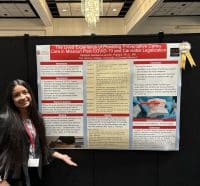MARTHA ROGER’S CONCEPTUAL theory, Science of Unitary Human Beings, was both comprehensive and visionary. Her grand theory integrated humankind and the environment, which together constituted the “universe”. This perceived universe would manifest itself in an innovative, ever-growing transformation and a continual evolutionary process. She considered facts, ideas, postulates, meanings, and relationships formed the foundation of this framework. She also believed that health care professionals should be creative and optimistic in their pursuits that lead to a synergistic body of knowledge for all of humankind, especially in the nursing discipline (Baumann, Wright, & Settecase-Wu, 2014).
THE PRINCIPLES
Rogers’ Science of Unitary Human Beings builds upon three homeodynamic principles: resonancy, helicy, and integrality. First, resonancy is the energy field that surrounds a person and how that energy field changes from one event to the next. When events happen in life, such as an illness, injury, wellness, or emotions, there will be a change in the energy field of a person. This energy can change from high to low, or vice versa, or be set in a rhythmic or dysrhythmic function. Life events can trigger positive or negative responses to a person’s energy field, which can alter their resonancy (Baumann, Wright, Settecase-Wu, 2014; & Butcher, 2023). Examples of positive responses might include getting plenty of sleep or hydration to restore the body’s resonancy to a level of optimal wellness. Negative responses might be a bacterial infection in the bloodstream affecting body organs.
Secondly, helicy is the way in which a person can change under normal or extreme circumstances. Every day is a learning experience and once something is learned, it cannot be unlearned unless by injury or disease. Life is always moving, always shifting to one degree or another. A person can learn from their mistakes and accept advice that will help them grow and improve their circumstances. If a person is not growing and changing due to illness or injury, then that person will need an intervention to help them along life’s path, such as coping mechanisms or physical therapy. Human life is never the same from one moment to the next and a person needs to have the ability to adjustments to their well-being (Butcher, 2023).
Lastly, integrality is the way in which a person sees themselves as a whole and how they fit in this “universe”. Life is a series of events, and all these events need to be put together to make any sense. To the casual observer it might seem they are separate from what they are observing, but this theory suggests instead, that the observer is an integral part of what he or she is observing. In other words, the observer is never separate from the environment (Butcher, 2023). For example, a student nurse might see other nurses with positive “bedside” manners and reproduce that attitude in their practice. Nurses may look at integrality as a way of connecting or interacting with patients with the realization that each belongs to the same environment.
THE POSTULATES
Along with these three homeodynamic principles, Rogers identifies four main nursing postulates to reinforce relevance into the nursing process. These postulates include energy fields, openness, patterning, and pandimensionality. These postulates do not stand on their own but function together. When defining energy fields, we see that energy distribution is formed or shaped when our energy is used and perceived. The author Butcher describes Roger as believing that “Human beings do not have an energy field, they are an energy field” (Butcher, 2023). Meaning that energy fields do not have parts and that human beings are irreducible but represent as the unitary whole (Butcher, 2023). For example, a person’s energy level is disrupted while fighting off an infection. The whole body must work together to restore the natural flow of energy to its hemodynamic stability.
Secondly, openness is the way in which everything is connected to everything else. According to Rogers, openness between humans and environmental fields are constantly open and extend beyond infinity where boundaries are nothing more than an illusion. Or another way to view it, everything is connected or inseparable in one way or another (Butcher, 2023). Thirdly, patterning is what makes each of us unique. We perceive things as different because of the way it is organized. Hence, patterning can be defined as a manifestation of energy fields that are constantly dynamic, unpredictable, and changing. Basically, it is what gives an energy field its identity. Rogers believed that patterning was always evolving, yet creative and continuously innovative (Butcher, 2023).
And finally, pandimensionality is a condition of thinking outside our own reality or existence where no boundaries exist. Further, this postulate provides a better scientific explanation to our understanding between the human, environment, and health experiences in the infinite multiverse (Bucher, 2023). Examples that express pandimensionality might include “…the healing power of prayer, therapeutic touch, out of body experiences, phantom pain, precognition…” (Butcher, 2023) to name a few.
Roger’s Science of Unitary Human Beings is one of several highly complex nursing theories which teaches nurses to think beyond their traditional scope of reasoning when treating the patient’s problem or illness. Many nurses find Marth Roger’s theory difficult and challenging to understand as well as apply it to everyday use in the clinical setting, especially the context of the language. Roger’s theory addresses the three homeodynamic principles of resonancy, helicy, and integrality while incorporating the four nursing postulates of energy distribution, openness, patterning, and pandimensionality. These theoretical descriptions do not exist separately but are intertwined philosophically to help our understanding of Roger’s theory.
References
Baumann, S. L., Wright, S. G., & Settecase-Wu, C. (2014). A Science of Unitary Human Beings Perspective of Global Health Nursing. Nursing Science Quarterly, 27(4). doi: 10.1177/0894318414546412.
Butcher, H. (2023).The Postulates in the Science of Unitary Human Beings. Iowa Pressbooks. Retrieved https://pressbooks.uiowa.edu/rogeriannursingscience/chapter/chapter-4-the-science-of-unitary-human-beings-postulates/.



























